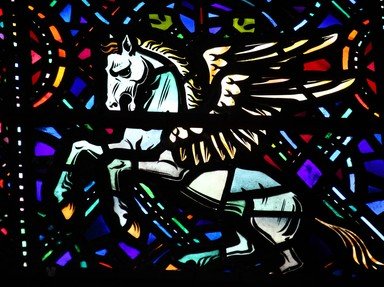Quiz Answer Key and Fun Facts
1. The Greek Titan Prometheus earned the enmity of Zeus, first by tricking him into accepting sacrifices without any meat, and later, by stealing fire from the gods and giving it to mankind. For his offenses, how was Prometheus punished?
2. After his friend Enkidu dies, this man obsesses about immortality, and nearly achieves it with a magical youth-restoring plant which is later stolen by a serpent. Thus, the King of Uruk has to resign himself to death. Who is this namesake of an ancient Sumerian epic, one of the oldest known works of literature?
3. When the Norse god Baldr had a dream that foretold his death, his Aesir clan and his mother, Frigg, worried about her son's death, which legendarily would precede Ragnarok, the end of the world. Thus, she exacted a bargain with all living things: don't hurt my son! Well, nearly all living things. What object was the cause of Baldr's death?
4. According to one Native American myth, this animal gave his blanket to a stone called Iya, but when it started raining, went back on the deal and stole back his blanket. Bad move: Iya ran him over, and this animal was not in good shape.
Who is this common figure in many Native American myths, a trickster canine not afraid of striking up a bargain?
5. Normal bargaining tricks didn't work for Isis; instead, she had to resort to drastic measures to figure out the true name of the Egyptian sun god. According to Egyptian myth, which god did she poison with a snake and refuse to heal until he revealed his true name?
6. After her brother Susanoo went crazy and threw a flayed horse at her, the sun kami Amaterasu shut herself into a cave, determined never to come out. The world lost its heat and warmth, and was only regained through a bargain the other kami made. They decided to dance, and the sound lured Amaterasu out of her cave.
In which Asian religion does that mythology play a major role?
7. To decide where they want to start building their new city, two brothers cut a bargain. One set up at Palatine Hill, the other at Aventine Hill, and they competed to determine who could see more divine signals. Palatine Hill got twelve vultures, and Aventine only got six, so Palatine became the site of a new city.
Who were the two brothers who legendarily struck that bargain?
8. In order to share the world's stories, a figure in African mythology was forced to accept Nyame's tough bargain: bring back four different creatures, all difficult to be captured. This trickster god managed to figure it out, though. Who is this iconic spider-figure from West African and Caribbean myth?
9. One Arthurian knight struck a bargain with a mysterious figure: this knight was allowed to strike the stranger with a deadly blow, if he returned a year and a day later to have the favor returned. Never one to shy away from a fight, this knight accepted the deal, but luckily wasn't required to offer his neck.
Who was this knight who had an encounter with the Green Knight?
10. Of course, when it comes to bargains in mythology, perhaps the most iconic bargain is one offered by a Germanic scholar eager to learn knowledge. Thus, he sells his soul to the Devil in exchange for pleasure and magical powers.
Who is this figure, immortalized in literary and musical works?
Source: Author
adams627
This quiz was reviewed by FunTrivia editor
looney_tunes before going online.
Any errors found in FunTrivia content are routinely corrected through our feedback system.

